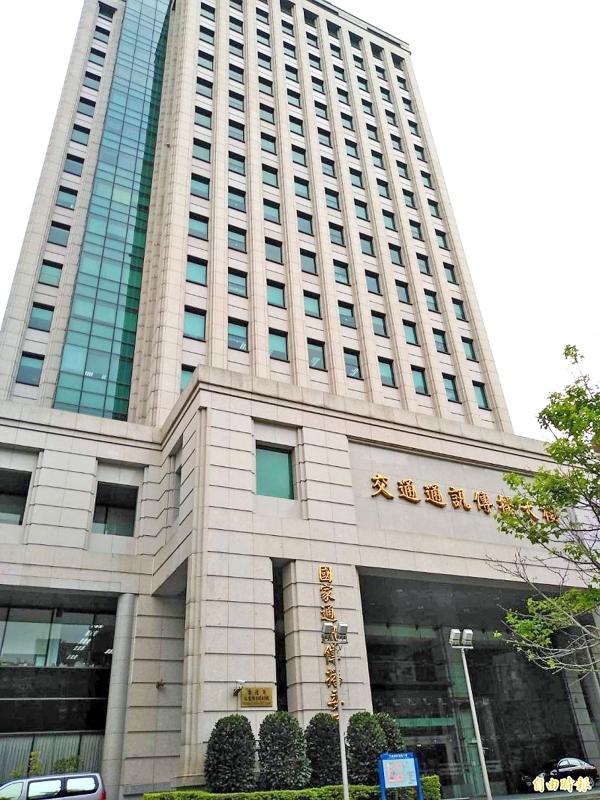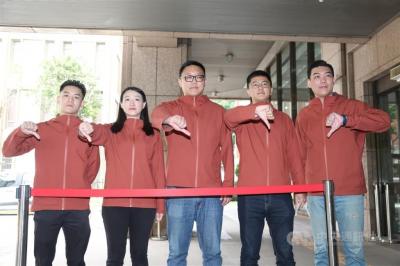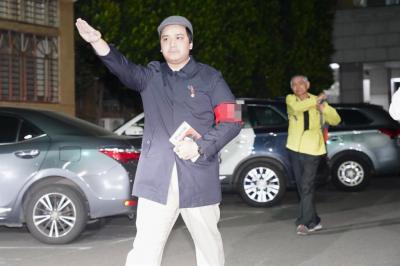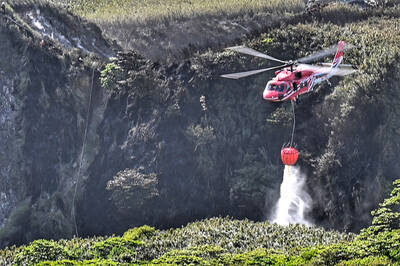China Television (CTV) received a passing grade for its performance from 2016 to 2019, although it must lower its debt ratio to below 60 percent before its operating license expires in 2025 while not firing employees for adhering to its own broadcasting guidelines, the National Communications Commission (NCC) said yesterday.
It was CTV’s first performance review since the network’s license renewal application was approved in 2016, the commission said.
A terrestrial television license is valid for nine years, and the commission is authorized to evaluate a licenced network’s performance every three years.

Photo: Yang Mien-chieh, Taipei Times
The review of CTV’s performance from July 1, 2016, to June 30, 2019, took nearly two years, as the network was repeatedly asked to provide additional information on plans to improve its financial situation, and enhance the quality of its news programs and political talk shows, the commission said.
NCC data showed that the network has registered capital of NT$1.5 billion (US$54.11 million), but its debt ratio never dropped below 80 percent in the three-year evaluation period, it said.
The passing grade was granted on two conditions, the NCC said.
As the commission next year is to evaluate the network’s performance from July 1 last year to June 30 next year, CTV should submit a detailed financial improvement plan before the evaluation period ends, it said.
Moreover, it must reduce its debt ratio from 80 percent to below 60 percent before its operating license expires on June 30, 2025, the commission said.
CTV’s management should create guidelines for its news production and provide key items from its contract with news department employees, which should be made terms of its contracts with such personnel, it said.
“Former CTV chairwoman Chiu Chia-yu (邱佳瑜) was found to have interfered in the operations of CTi News, which is part of the Want Want China Times Group,” the commission said. “As such, contracts must clearly state that CTV’s management must not hand down decisions unfavorable to employees if they exert rights or privileges stated in the guidelines.”
CTV is not being singled out by the requirement to incorporate broadcasting guidelines with its contracts with employees, said NCC Vice Chairman Wong Po-tsung (翁柏宗), the commission’s spokesman.
The NCC last week imposed the same requirement on Sanlih E-Television’s iNews when it approved a request to move it to channel 48, Wong said.
The commission has not found evidence that CTV is under undue influence from large shareholders or third parties, he said.
CTV’s management must revise its broadcasting guidelines, provide the employment guidelines and submit the revised guidelines to the commission within six months after it is officially notified about the evaluation, the commission said.
The network should enforce the revised broadcasting guidelines, which must prevent its largest shareholder or others from coercing employees at the news department to cover stories in ways that contradict its code of journalistic ethics, the commission said.
CTV must also stipulate guidelines governing production and broadcast of political talk shows, it added.
In other news, the commission is to provide an additional NT$65 million to compensate 402 radio and television stations for losses incurred by broadcasting disease prevention information from the Central Epidemic Command Center.
Since last year, the commission has spent NT$99 million to subsidize broadcast media for airing disease prevention information, it said.

Taiwan is stepping up plans to create self-sufficient supply chains for combat drones and increase foreign orders from the US to counter China’s numerical superiority, a defense official said on Saturday. Commenting on condition of anonymity, the official said the nation’s armed forces are in agreement with US Admiral Samuel Paparo’s assessment that Taiwan’s military must be prepared to turn the nation’s waters into a “hellscape” for the Chinese People’s Liberation Army (PLA). Paparo, the commander of the US Indo-Pacific Command, reiterated the concept during a Congressional hearing in Washington on Wednesday. He first coined the term in a security conference last

Prosecutors today declined to say who was questioned regarding alleged forgery on petitions to recall Democratic Progressive Party (DPP) legislators, after Chinese-language media earlier reported that members of the Chinese Nationalist Party (KMT) Youth League were brought in for questioning. The Ministry of Justice Investigation Bureau confirmed that two people had been questioned, but did not disclose any further information about the ongoing investigation. KMT Youth League members Lee Hsiao-liang (李孝亮) and Liu Szu-yin (劉思吟) — who are leading the effort to recall DPP caucus chief executive Rosalia Wu (吳思瑤) and Legislator Wu Pei-yi (吳沛憶) — both posted on Facebook saying: “I

Sung Chien-liang (宋建樑), who led efforts to recall Democratic Progressive Party (DPP) Legislator Lee Kun-cheng (李坤城), was released on bail of NT$80,000 today amid outcry over his decision to wear a Nazi armband to questioning the night before. Sung arrived at the New Taipei District Prosecutors’ Office for questioning in a recall petition forgery case last night wearing a red armband bearing a swastika, carrying a copy of Adolf Hitler’s Mein Kampf and giving a Nazi salute. Sung left the building at 1:15am without the armband and covering the book with his coat. Lee said today that this is a serious

A mountain blaze that broke out yesterday morning in Yangmingshan National Park was put out after five hours, following multi agency efforts involving dozens of fire trucks and helicopter water drops. The fire might have been sparked by an air quality sensor operated by the National Center for High-Performance Computing, one of the national-level laboratories under the National Applied Research Laboratories, Yangmingshan National Park Headquarters said. The Taipei City Fire Department said the fire, which broke out at about 11am yesterday near the mountainous Xiaoyoukeng (小油坑) Recreation Area was extinguished at 4:32pm. It had initially dispatched 72 personnel in four command vehicles, 16